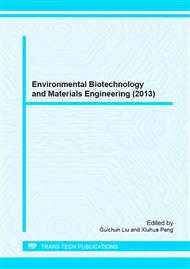p.151
p.161
p.168
p.173
p.178
p.182
p.187
p.192
p.196
Performances of Dominant Thermophilic Cellulolytic Bacteria for the Bio-Drying
Abstract:
Six dominant thermophilic cellulolytic bacteria were separated from undigested dewatered sludge. By analysis of their water content, value of hydrolysis up, rate of weight loss of filter paper and CMC-enzyme activity, a dominant thermophilic cellulolytic bacterium named XW5 was separated and inoculated in the dewatered sludge under simulating bio-drying conditions. The results showed that water content of the dewatered sludge which was inoculated dominant bacterium was decreased from an initial 70.05% to 62.49%.
Info:
Periodical:
Pages:
178-181
Citation:
Online since:
September 2013
Authors:
Price:
Сopyright:
© 2013 Trans Tech Publications Ltd. All Rights Reserved
Share:
Citation:


